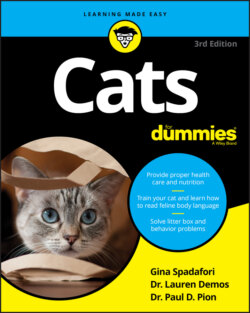Читать книгу Cats For Dummies - Gina Spadafori - Страница 32
Longhaired beauties
ОглавлениеThe Persian is the other cat besides the Siamese that nearly anyone, cat lover or not, can recognize. The incredible coat of this breed has enchanted cat lovers for centuries. Whenever companies look for a breed that says “glamour” to use in their advertising, that they often settle on a Persian is no accident. This cat is a glamour-puss, no doubt about it (see Figure 2-4).
© John Wiley & Sons, Inc.
FIGURE 2-4: The Birman, Himalyan and Persian are all cherished for their luxurious, long coats.
Perhaps no cat besides the Persian comes in as many varieties, each cat resplendent in that incredible coat: tabbies of every color, torties, calicos, every imaginable solid color, and tipped coats, too. The markings of the Siamese can be found in the Himalayan, which in cat shows is considered a pointed Persian.
If you’re looking for a more natural longhair, you have plenty of options. The Turkish Angora and Turkish Van are two ancient longhaired cats. The Norwegian Forest, Maine Coon, and Siberian cats are longhairs that still have the rough-and-tumble look of farm cats about them. And don’t forget the Birman, the sacred cat of Burma, a breed that looks somewhat like a Himalayan, with color darker at the points, except for the perfectly white-mitted paws.
The Ragdoll is another pointed longhair with white mittens of more-modern origins — it was “invented” in the 1960s — and is another choice for those seeking a longhaired cat, especially one designed to have an extremely laid-back temperament. Another lovely longhair with a relatively short history is the Chantilly/Tiffany, a cat with silky hair, commonly chocolate colored.
In the longhaired ranks, too, are a few breeds you can distinguish from their better-known relatives only by the length of their coat. Put in this class the Cymric, a longhaired version of the tailless Manx, as well as the Somali (a longer-haired Abyssinian), Balinese (a longer-haired Siamese), and Javanese (a longer-haired Colorpoint Shorthair).
The biggest challenge facing those who own longhaired cats is coat care. The long, silky coat of the Persian mats easily and requires daily attention to keep it in good form. Other longhaired coats aren’t quite as demanding, but they all require more attention than the coats of shorthaired cats. And they all shed rather remarkably! Ingested hair, commonly called hairballs, is a bigger problem in longhaired cats, too.
The temperament of longhaired cats depends on what’s underneath that lovely coat. If an Oriental body is underneath — such as in the Balinese — you’ve got an active cat. The larger, more thickset body types, such as those of the Persian and Norwegian Forest Cat, tend more toward the laid-back end of the spectrum.
